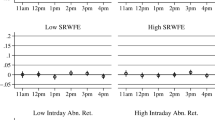Abstract
This paper aims to estimate the effect of imposing a reserve price in repeated auctions of homogeneous items. I model the behavior of impatient bidders who search for the best auction outcome over time. The model is used to develop estimating equations for the bidders’ valuations, and to evaluate the effect of reserve prices on bids and revenue. Using data collected from surplus auctions of personal computer processors, I find economically significant gains from imposing a reserve price. The revenue-maximizing reserve price improves revenue by about 23% for a large subsample of the auctions in the data.
Similar content being viewed by others
References
Athey S., Haile P. A. (2007) Nonparametric approaches to auctions. In: Heckman J., Learner E. (eds) Handbook of Econometrics, Vol. 6 part 1.. North Holland Pub Co, New York, pp 3847–3965
Ashenfelter O. (1989) How auctions work for wine and art. Journal of Economic Perspectives 3: 23–36
Bajari P., Hortaçsu A. (2004) Economic insights from internet auctions. Journal of Economic Literature 42: 457–486
Brendstrup B., Paarsch H. J. (2006) Identification and estimation in sequential, asymmetric, English auctions. Journal of Econometrics 134: 69–94
Caillaud B., Mezzetti C. (2004) Equilibrium reserve prices in sequential ascending auctions. Journal of Economic Theory 117: 78–95
Donald S. G., Paarsch H. J., Robert J. (2006) An empirical model of the multi-unit, sequential, clock auction. Journal of Applied Econometrics 21: 1221–1247
Gale D. (1986) Bargaining and competition part I: Characterization. Econometrica 54: 785–806
Genesove D. (1995) Search behavior at wholesale auto auctions. Quarterly Journal of Economics 110(1): 23–49
Grant S., Kajii A., Menezes F., Ryan M. J. (2006) Auctions with options to re-auction. International Journal of Economic Theory 2: 17–39
Haile P. A., Tamer E. (2003) Inference with an incomplete model of English auctions. Journal of Political Economy 111(1): 1–51
Hortacsu A., McAdams D. (2010) Mechanism choice and strategic bidding in divisible good auctions: An empirical analysis of the Turkish treasury auction market. Journal of Political Economy 118(5): 833–865
Hortacsu A., Puller S. L. (2008) Understanding strategic bidding in multi-unit auctions: A case study of the Texas electricity spot market. RAND Journal of Economics 39(1): 86–114
Ichimura H. (1993) Semiparametric least squares (SLS) and weighted SLS estimation of single-index models. Journal of Econometrics 58: 71–120
Jofre-Bonet M., Pesendorfer M. (2003) Estimation of a dynamic auction game. Econometrica 71: 1443–1489
Lucking-Reiley D. (2000) Auctions on the internet: What’s being auctioned, and how. Journal of Industrial Economics 48: 227–252
McAfee R. P. (1993) Mechanism design by competing sellers. Econometrica 61: 1281–1312
McAfee R. P., Vincent D. (1997) Sequentially optimal auctions. Games and Economic Behavior 18: 246–276
McCall John J. (1970) Economics of information and job search. Quarterly Journal of Economics 84: 113–126
Monroe K. B. (1990) Pricing: Making profitable decisions. McGraw-Hill Pub Co, New York
Mortensen D. T. (1970) Job search, the duration of unemployment, and the phillips curve. American Economic Review 60: 847–862
Ockenfels A., Reiley D., Sadrieh A. (2007) Online auctions. In: Hendershott T. (eds) Economics and information systems. Elsevier, Amsterdam, pp 571–628
Rogerson R., Shimer R., Wright R. (2005) Search-theoretic models of the labor market: A survey. Journal of Economic Literature 43: 959–988
Rothkopf M., Harstad R. (1994) On the role of discrete bid levels in oral auctions. European Journal of Operations Research 74: 572–581
Rothkopf M., Harstad R. (1994) Modeling competitive bidding: A critical essay. Management Science 40: 364–384
Rubinstein A., Wolinsky A. (1985) Equilibrium in a market with sequential bargaining. Econometrica 53: 1133–1150
Silverman B. W. (1986) Density estimation for statistics and data analysis. Chapman and Hall, London
Author information
Authors and Affiliations
Corresponding author
Additional information
The opinions expressed in this article are those of the author and do not necessarily represent the views of the Federal Communications Commission, its commissioners, or the United States Government.
Rights and permissions
About this article
Cite this article
Carare, O. Reserve Prices in Repeated Auctions. Rev Ind Organ 40, 225–247 (2012). https://doi.org/10.1007/s11151-011-9321-9
Published:
Issue Date:
DOI: https://doi.org/10.1007/s11151-011-9321-9




